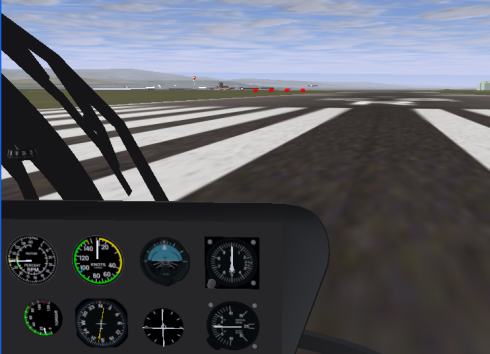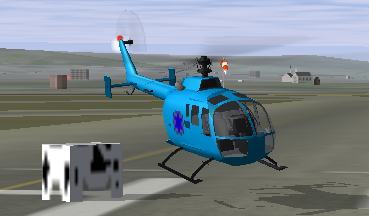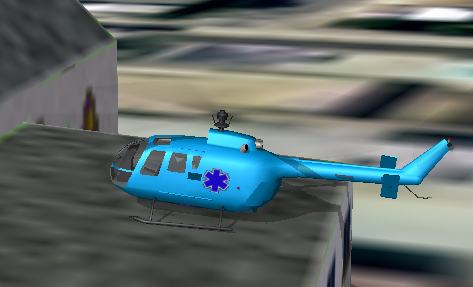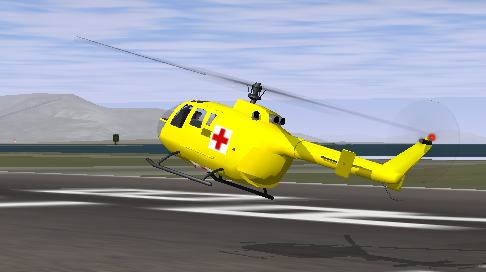Howto:Fly a helicopter
Very first: I would be very thankful, if one could correct this introduction to correct English!
Preface
First: in principle everything that applies to real helicopters, applies also to Flightgear. Fundamental maneuvers are well described on: http://www.cybercom.net/~copters/pilot/maneuvers.html Some details are simplified in Flightgear, in particular the engine handling and some overstresses are not simulated or are without any consequence. In Flightgear it is (up to now) not possible to damage a helicopter in flight.
Since the release of version 0.9.10 some improvements have been made to the helicopter flight model and therefore the CVS version should be used. With these improvements the helicopter flight model of Flightgear should be quite realistic. The only exceptions are “vortex ring conditions”. These occur if you descend too fast and perpendicularly (without forward speed). The heli can get into its own rotor downwash causing the lift to be substantially reduced. Recovering from this condition is possible only at higher altitudes. On the Internet you can find a video of a Seaking helicopter, which got into this condition during a flight demonstration and touched down so hard afterwards that it was completely destroyed.
For all Flightgear helicopters the parameters are not completely optimized and thus the performance data between model and original can deviate slightly. On the hardware side I recommend the use of a “good” joystick. A joystick without springs is recommended because it will not center by itself. You can have this by modifying (removing the spring) from a normal joystick, or by using a force feedback joystick, with a disconnected voltage supply. Further, the joystick should have a “thrust controller” (throttle). For controlling the tail rotor you should have pedals or at least a twistable joystick, keyboard would be the hard way. (Hint: Flightgear supports more than one joystick attached at the same time.)
Getting started
The number of available helicopters in FlightGear is limited. In my opinion the Bo105 is the easiest to fly, since it reacts substantially more directly than other helicopters. For flight behavior I can also recommend the as350, though there is no 3D-model - it uses the Bo105 3D-model. The As350 reacts more retarded than the Bo.
Once you have loaded FlightGear, take a moment to centralize the controls by moving them around. In particular the collective is often at maximum on startup.
The helicopter is controlled by four functions. The stick (joystick) controls two of them, the inclination of the rotor disc (and thus the inclination of the helicopter) to the right/ left and forwards/back. Together these functions are called “cyclic blade control”. Next there is the “collective blade control”, which is controlled by the thrust controller. This causes a change of the thrust produced by the rotor. Since the powering of the main rotor transfers a torque to the fuselage, this must be compensated by the tail rotor. Since the torque is dependent on the collective and on the flight condition as well as wind can add additional torque on the fuselage, the tail rotor is also controlled by the pilot using the the pedals. If you push the right pedal, the helicopter turns to the right (!). The pedals are not a steering wheel. Using the pedals you can yaw helicopter around the vertical axis. The number of revolutions of the rotor is kept constant (if possible) by the aircraft.
Lift-Off
At first reduce the collective to minimum. To increase the rotor thrust, you have to “pull” the collective. Therefore for minimum collective you have to push the control down (that is the full acceleration position (!) of the thrust controller). Thus: Thrust controller to “full power” what means minimum collective. The engine is started with “}”. After few seconds the rotor starts to turn and accelerates slowly. Hold the stick and the pedals approximately in centered position. Wait until the rotor finish its accelerated (there is an instruments for engine and rotor speed, in the Bo105 on the left in the upper row). Then pull the collective slowly (really slowly!!!). Observe exactly the horizon. If the heli tilts or turns only a little bit, stop increasing the collective and correct the position/movement with stick and pedals. If you are successful, continue pulling the collective (slowly!). If the helicopter flies, increase the collective a little bit more and try to keep the helicopter in a leveled position. The main difficulty is it to react to an inadvertent rotating motion of the helis with the correct measure. Only three things can help you: practice, practice and practice. It is not unusual that the time one needs to get a halfway good looking hovering flight is to be measured not in minutes, but in hours. Note: The stick position in stable hover is not the center position of the joystick.
In the air
In order not to let the frustration win the upper hand, it is recommendable to try occasionally the forward flight. After take off continue pulling the collective a short time and than lower the nose a little bit by a short forward movement of the stick. The heli accelerates forward. With forward speed the tail rotor does not have to be controlled precisely due to the wind flag effect. Altogether the flight behavior in forward flight is quite similar to that of an (bad trimmed) airplane. The “neutral” position of the stick is different depending upon airspeed and collective.
The transition of the forward flight to the hovering flight is at the simplest, if you reduce the speed only slowly by raising the nose of the helicopter only a little bit. Reduce the collective, otherwise the heli would climb. If the heli gets rather slow, the so called “translation lift” is reduced, and you must compensate this by pulling the collective. If the speed is reduced nearly to zero, lower the nose at it was in hovering, otherwise the heli accelerates immediately backwards.
Back to Earth I
To land the helicopter do the same as described before, additionally lower the altitude within. Briefly before hitting the ground reduce the rate of descent slowly. A perfect landing is achieved, if you reduce at the same time altitude, speed and descent rate and all three parameters get zero simultaneously (important: gently). However, such landing are extremely difficult. Most pilots perform a hover more or less near to the ground and than decent slowly to the ground. Also a landing with forward travel speed is easier, however one must assure to touch down without lateral speed to avoid a rollover. Since the ground in Flightgear is free from all unevenness, this kind of landing is simpler than in the reality.
Back to Earth II
I like to mention the autorotation briefly. This is a unpowered flight condition, where alone air flowing by the rotor propels the rotor. In appropriate altitude select a landing point (at first in the size of a larger airfield) and then switch the engine off by pressing "{". Reduce collective to minimum, place the tail rotor to approximately 0 degrees incidence (with the Bo push the right pedal about half , with As350 the left). Approach with approximately 80 knots. The rotor speed may not rise more than a few percent over 100%, otherwise the rotor would be damaged (this is not simulated up to now). In time before reaching the ground reduce the airspeed by lifting the nose. The descent rate will be reduced by this as well, you do not need to pull collective now. However it can be that the rotor speed rises here beyond the permitted range. Avoid this by increasing the collective if needed. Closely over the ground reduce the descent rate by pulling the collective. The goal is it to touch down with very small descent rate and without forward speed. With forward speed it is easier, however the danger of a roll over exists, if the skids are not aligned parallel to the flight direction. During the approach it is not necessary to adjust the tail rotor, since without power there is almost no torque. If you feel (after some practicing), that the autorotation is too simple, considers that only you without any further ballast are in the helicopter. You can adjust this in the menu.
Much fun with the Flightgear helicopters.



